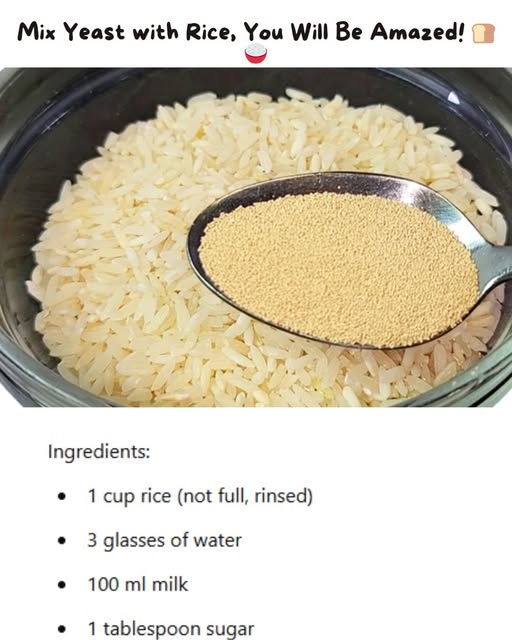Mix Yeast with Rice, You Will Be Amazed! 🍞🍚
Breadmaking has been a cornerstone of culinary traditions for centuries, with countless variations emerging from cultures worldwide. While wheat flour is the go-to ingredient for most bread recipes, innovative bakers have explored creative combinations, resulting in unique and delightful creations. One such game-changing recipe involves mixing yeast with rice—a seemingly unconventional duo that yields surprisingly soft, tender bread with a rich flavor and an irresistible texture.
This essay delves into the process, benefits, and cultural significance of this unique bread, demonstrating why mixing yeast with rice is a culinary experiment worth trying.
Ingredients That Redefine Breadmaking
1. Rice (1 cup, rinsed)
Rice, a staple grain in many global cuisines, serves as the unexpected hero of this recipe. Its starches contribute to the bread’s softness and moisture, creating a texture that is both tender and satisfying.
2. Water (3 glasses)
Essential for cooking the rice and binding the dough, water plays a critical role in achieving the right consistency.
3. Milk (100 ml)
Milk adds richness and a subtle sweetness to the bread, enhancing its flavor profile.
4. Sugar (1 tablespoon)
Sugar not only activates the yeast but also imparts a mild sweetness that complements the rice.
5. Yeast (1 teaspoon)
Yeast is the powerhouse behind the bread’s rise, creating the airy structure that makes this recipe so appealing.
6. Flour (3 glasses)
Flour provides the foundation for the dough, balancing the rice’s softness with a sturdy structure.
7. Salt (0.5 teaspoon)
Salt enhances flavor and strengthens the dough, ensuring the bread holds its shape during baking.
8. Vegetable Oil (2 tablespoons)
Oil contributes to the bread’s tenderness and prevents it from drying out during baking.
The Step-by-Step Process
1. Cooking the Rice
The process begins by cooking the rinsed rice in three glasses of water until it’s fully done. This step is crucial because the rice must be soft enough to integrate seamlessly into the dough. After cooking, the rice is left to cool slightly for 15 minutes. Cooling ensures it doesn’t interfere with the yeast activation in the next steps.
2. Activating the Yeast
In a separate bowl, milk, sugar, and yeast are combined. This mixture is left to sit for a few minutes until the yeast activates, creating a frothy surface. The activation of yeast is a magical moment in baking, as it sets the stage for the dough’s rise and ensures the bread’s soft texture.
3. Mixing the Ingredients
CONTINUE READING ON THE NEXT PAGE

